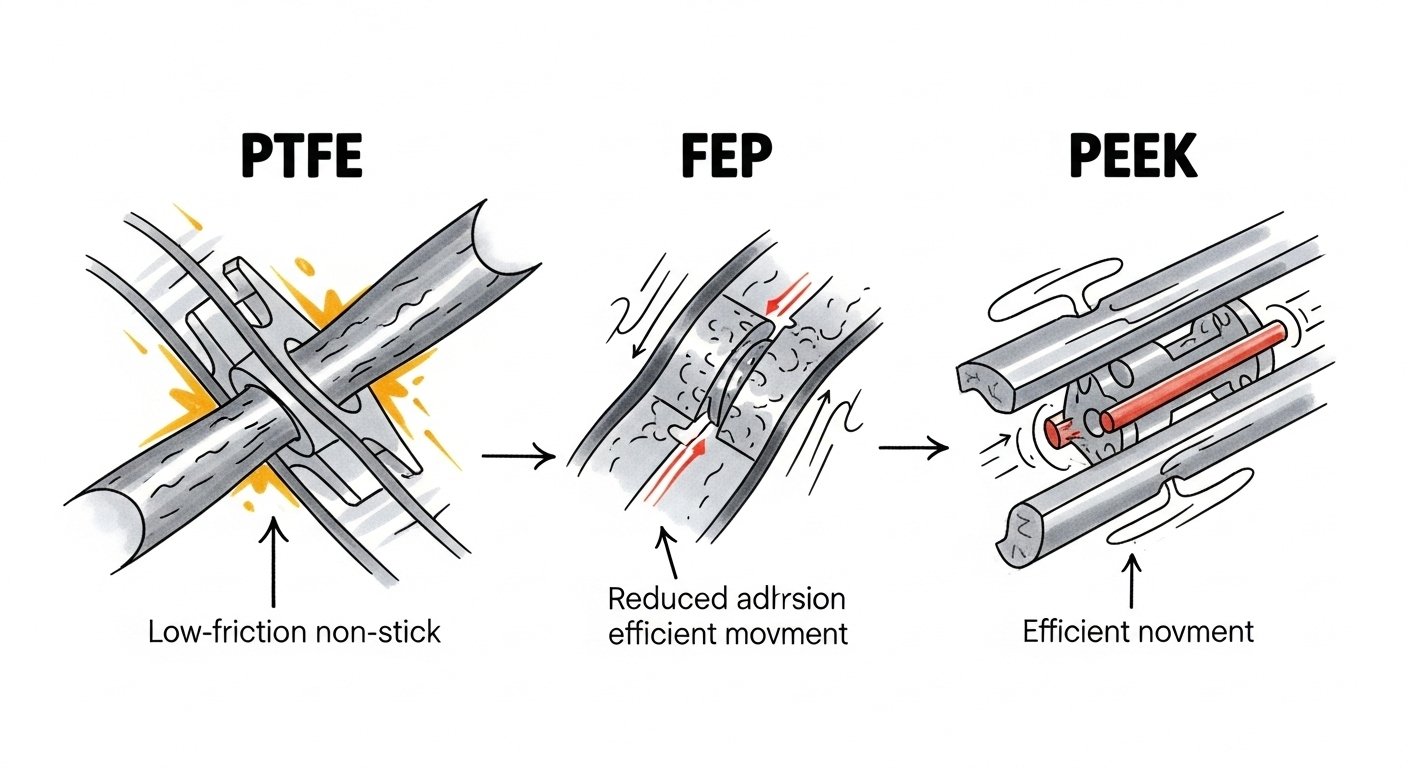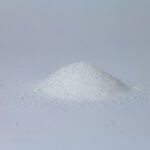Introduction Low-Friction & Non-Stick Polymers (PTFE, FEP, PEEK)
In mechanical systems involving relative motion—such as linear slides, rotary bearings, seals, and conveyor systems—friction and wear are inevitable forces that lead to energy loss, component degradation, increased maintenance, and potential failure. Selecting the right material for these dynamic applications is crucial for optimizing performance, longevity, and efficiency. Low-friction and non-stick polymers, particularly PTFE (Polytetrafluoroethylene), FEP (Fluorinated Ethylene Propylene), and PEEK (Polyether Ether Ketone), offer exceptional solutions for motion systems. Each material brings unique advantages: PTFE and FEP for their inherently low coefficients of friction and chemical inertness, and PEEK for its superior mechanical strength, wear resistance, and ability to operate effectively without lubrication. This article explores how these high-performance polymers address the challenges of motion systems.
Key Properties for Low-Friction Applications
- Low Coefficient of Friction: Minimizes resistance between moving parts, reducing energy consumption and wear.
- Excellent Wear Resistance: Especially PEEK, and filled grades of PTFE (e.g., glass, carbon, bronze filled), providing durability under sliding or rotating contact. Suitable for dry running conditions.
- Chemical Resistance: Withstand exposure to lubricants, cleaning agents, and process fluids.
- Wide Temperature Range: Perform reliably in both hot and cold environments.
- Self-Lubricating: Reduce or eliminate the need for external lubricants, which can attract contaminants or degrade over time.
Xiflon’s Low-Friction Material & Component Offerings
We supply materials optimized for creating low-friction and wear-resistant parts:
- PTFE Semi-Finished Products: Rods, tubes, and sheets for machining low-friction bearings, bushings, and wear pads. Filled PTFE grades available for enhanced wear resistance.
- FEP Semi-Finished Products: Transparent, low-friction components for applications requiring visual monitoring.
- PEEK Semi-Finished Products: High-strength rods, tubes, and sheets for machining bearings, gears, and structural wear components. Excellent for high-load applications.
- Custom Machined Components: Precision CNC machining of PTFE, FEP, and PEEK into custom bearings, bushings, seals, guide strips, and other motion system parts.
- Injection Molded Parts: Complex PEEK, FEP, and PFA components designed for low friction and wear.
Comparing PTFE, FEP, and PEEK for Motion Systems
PTFE (Polytetrafluoroethylene)
- Friction: Lowest coefficient of friction among common engineering plastics.
- Wear Resistance: Good, but can be improved with fillers (carbon, glass) for high-load applications.
- Strength: Low tensile strength, can deform under high loads or pressures.
- Chemical Resistance: Excellent – virtually inert.
- Temperature Range: -200°C to +260°C.
- Applications: Ideal for low-load bearings, non-stick surfaces, and chemical-resistant seals.
FEP (Fluorinated Ethylene Propylene)
- Friction: Low friction, slightly higher than PTFE.
- Wear Resistance: Similar to PTFE, can be filled for improvement.
- Strength: Better mechanical properties than PTFE.
- Chemical Resistance: Very good, nearly as resistant as PTFE.
- Temperature Range: Up to approximately 200°C.
- Transparency: Fully transparent, allowing visual inspection.
- Applications: Low-friction, transparent components for laboratory or food processing equipment.
PEEK (Polyether Ether Ketone)
- Friction: Low to moderate friction, excellent wear resistance.
- Wear Resistance: Excellent, especially in unfilled or carbon-filled grades. Superior to unfilled PTFE/FEP.
- Strength: High tensile strength and stiffness, maintains properties under load.
- Chemical Resistance: Good, resistant to many chemicals but not as universally inert as PTFE.
- Temperature Range: Up to approximately 250°C.
- Biocompatibility: Excellent, suitable for medical implants and repeated sterilization.
- Applications: High-load bearings, gears, structural components, and medical devices requiring wear resistance and strength.
Guidelines for Material Selection For Low-Friction & Non-Stick Polymers
- Choose PTFE when:
- The lowest friction or non-stick properties are required.
- Universal chemical resistance is essential.
- Electrical insulation is critical.
- Low mechanical load is sufficient.
- Cost sensitivity is a priority for simple parts.
Examples: Low-load bearings, non-stick surfaces, chemical seals, high-frequency insulators.
- Choose FEP when:
- Transparency is needed along with low friction.
- Good chemical resistance and moderate temperature performance are required.
- Melt-processability for complex shapes is beneficial.
Examples: Transparent guide strips, lab equipment bearings, food processing wear strips.
- Choose PEEK when:
- High mechanical strength, hardness, and wear resistance are needed.
- Excellent hydrolysis resistance is required (e.g., steam sterilization).
- Radiation resistance (gamma or e-beam) is a benefit.
- Metal replacement is desired for weight reduction.
- Biocompatibility is necessary for implants.
Examples: High-load bearings, aerospace structural components, medical implants, oil & gas wear components.
Key Applications For Low-Friction & Non-Stick Polymers
- Aerospace & Defense: Lightweight bearings, bushings, and seals for aircraft actuators and control systems.
- Automotive: Low-friction components for engines, transmissions, and suspension systems.
- Industrial Machinery: Bearings, guide ways, wear pads, and seals for pumps, compressors, and manufacturing equipment.
- Medical Devices: Implantable joints, surgical instruments, and diagnostic equipment components.
- Food & Beverage: Non-stick conveyor surfaces, low-friction guides, and FDA-compliant wear components.
- Oil & Gas: Seals and bearings for downhole tools and rotating equipment exposed to harsh chemicals and high pressures.
Quality and Compliance
- ISO 9001: Manufacturing processes adhere to rigorous quality management standards.
- Material Traceability: Full documentation, including Certificates of Conformity (CoC) and Material Safety Data Sheets (MSDS).
- Food-Grade Options: PTFE, FEP, and PEEK products available that meet FDA regulations for food contact.
- Medical-Grade Options: PEEK available meeting ISO 10993 biocompatibility standards for implants.
- Special Requirements: USP Class VI grades of PTFE available for pharmaceutical applications.

Low-Friction & Non-Stick Polymers (PTFE, FEP, PEEK) for Motion Systems
Conclusion Low-Friction & Non-Stick Polymers (PTFE, FEP, PEEK)
Low-friction and non-stick polymers like PTFE, FEP, and PEEK are essential for designing efficient, durable, and low-maintenance motion systems. Each material offers distinct advantages: PTFE for the lowest friction and chemical inertness, FEP for transparency and good processability, and PEEK for superior mechanical strength and wear resistance. Selecting the right polymer depends on the specific demands of load, speed, environment, and performance requirements. Xiflon supplies a comprehensive range of these high-performance materials in various semi-finished forms (rods, tubes, sheets) and as custom machined or molded parts, ensuring you can access the optimal solution for your motion system challenges. Our expertise in material properties and processing helps guide you to the best choice for maximizing system performance and longevity. Whether you need simple PTFE bushings or complex PEEK bearings, Xiflon delivers high-quality components meeting international standards (ISO 9001, FDA, REACH, etc.). Contact us to discuss your low-friction application needs.







